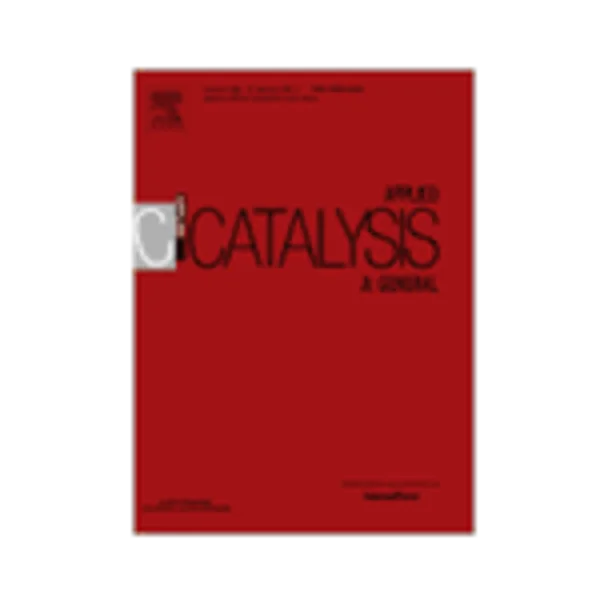-
dependency on chloride concentration and ‘in-sphere’ oxidation of h2o for the effective tio2-photocatalysed electron transfer from h2o to [pdcln(h2o)4−n]2−n (n = 0–4) in the absence of an added sacrificial reducing agent
جزئیات بیشتر مقاله- تاریخ ارائه: 1392/07/24
- تاریخ انتشار در تی پی بین: 1392/07/24
- تعداد بازدید: 988
- تعداد پرسش و پاسخ ها: 0
- شماره تماس دبیرخانه رویداد: -
the photocatalytic reduction trends of palladium chloride aqua complexes, [pdcln(h2o)4−n]2−n (n = 0–4), have been investigated employing titanium dioxide (tio2) as photocatalyst in the absence of an added sacrificial reducing agent (sra). solutions were prepared at those cl−-concentrations that coincide with the maximum of each species and the photocatalytic reduction behaviour of pd(ii) at these chloride-concentrations is related to the complex present in greater abundance. the photocatalytic reduction rate trend is observed to have the following decreasing order: pdcl2(h2o)2 > [pdcl(h2o)3]+ > [pd(h2o)4]2+ > [pdcl3(h2o)]− > [pdcl4]2−, with [pdcl4]2− showing resistance to photocatalytic reduction in the absence of an added sra. it is postulated that oxidation of the coordinated water molecules impacts on the rate of reduction. for those complexes for which the ratio h2o:cl− is greater than 50%, the oxidation of coordinated ‘in-sphere’ water molecules is working against an expected increase in the rate of reduction as predicted by the complexes’ standard reduction potentials. interplay between thermodynamics and adsorption/interaction of the palladium species on the catalyst surface is clearly at work in this system.
مقالات جدیدترین رویدادها
-
استفاده از تحلیل اهمیت-عملکرد در ارائه الگوی مدیریت خلاقیت سازمانی و ارائه راهکار جهت بهبود
-
بررسی تاثیر ارزش وجوه نقد مازاد بر ساختار سرمایه شرکت های پذیرفته شده در بورس اوراق بهادار تهران
-
بررسی تأثیر سطح افشای ریسک بر قرارداد بدهی شرکت های پذیرفته شده در بورس اوراق بهادار تهران
-
بررسی تأثیر رتبه بندی اعتباری مبتنی بر مدل امتیاز بازار نوظهور بر نقد شوندگی سهام با تأکید بر خصوصی سازی شرکت ها
-
تأثیر آمیخته بازاریابی پوشاک ایرانی بر تصویر ذهنی مشتری پوشاک ایرانی (هاکوپیان)
-
اصول تکنیک حفاری با مدیریت فشار
-
زمین شیمی هاله های دگرسانی و الگوی پراکنش عناصر خاکی کمیاب در کانسار مس پورفیری دره زار (کرمان)
-
طراحی منظر شهری مطلوب در مسیرهای پیاده (نمونه موردی محور گاوازنگ شهر زنجان)
-
بررسی تفاوت های استراتژی های قیمت گذاری مواد معدنی در ایران و جهان؛ مطالعه موردی سنگ آهن
-
microspectroscopic insight into the deactivation process of individual cracking catalyst particles with basic sulfur components
مقالات جدیدترین ژورنال ها
-
مدیریت و بررسی افسردگی دانش آموزان دختر مقطع متوسطه دوم در دروان کرونا در شهرستان دزفول
-
مدیریت و بررسی خرد سیاسی در اندیشه ی فردوسی در ادب ایران
-
واکاوی و مدیریت توصیفی قلمدان(جاکلیدی)ضریح در موزه آستان قدس رضوی
-
بررسی تاثیر خلاقیت، دانش و انگیزه کارکنان بر پیشنهادات نوآورانه کارکنان ( مورد مطالعه: هتل های 3 و 4 ستاره استان کرمان)
-
بررسی تاثیر کیفیت سیستم های اطلاعاتی بر تصمیم گیری موفق در شرکتهای تولیدی استان اصفهان (مورد مطالعه: مدیران شرکتهای تولیدی استان اصفهان)
-
کاربرد پدیدارشناسی در پژوهش های مرتبط با دانش اشیاء و تجارب موزه ای
-
تاثیر نقش والدین در حل مشکلات روانشناختی و پیشرفت تحصیلی دانش آموزان مقطع ابتدایی آموزش و پرورش شهرستان بمپور
-
بررسی و تحلیل نقدهای فمینیستی ادبیات کودک و نوجوان در نشریه تخصصی کتاب ماه کودک و نوجوان (1376-1393)
-
رابطه سه گانه تاریک شخصیت و صفات شخصیتی هگزاکو با پرخاشگری در دانشجویان
-
effectiveness of acceptance and commitment therapy on depression, anxiety and flexibility of divorced young women




سوال خود را در مورد این مقاله مطرح نمایید :